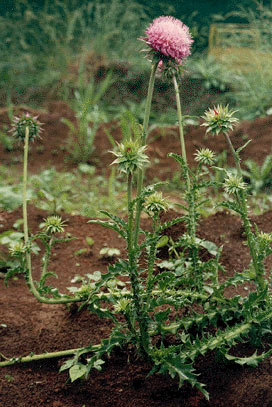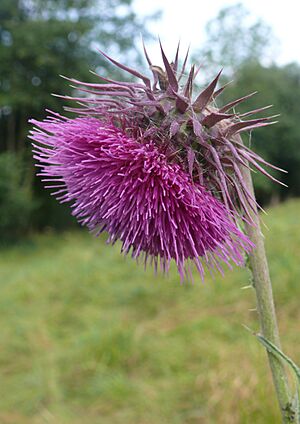Carduus nutans facts for kids
Quick facts for kids Carduus nutans |
|
|---|---|
 |
|
| Scientific classification | |
| Genus: |
Carduus
|
| Species: |
nutans
|
Carduus nutans, often called the musk thistle or nodding thistle, is a type of plant with showy red-purple flowers. It belongs to the sunflower family. This plant is originally from parts of Europe and Asia.
Where It Grows
The musk thistle is a native plant in Europe and Asia. However, it has been brought to many other places and continents. In these new areas, it often becomes an unwanted plant or a harmful weed.
This plant can grow from sea level up to about 2,500 meters (8,200 feet) high. It likes soils that are not too acidic or too alkaline. You can often find it in meadows and grasslands. It also grows well in places where animals graze a lot, like pastures. You might also see it on open, disturbed ground, such as next to roads or on building sites. It spreads quickly in areas that often have natural events like landslides or floods. However, it does not grow well if it's too wet, too dry, or too shady.
What It Looks Like
The musk thistle is usually a biennial plant. This means it takes two years to complete its life cycle and produce seeds. However, in warmer places, it might grow and flower in just one year. Young plants can start growing from spring to late summer. They first form a flat group of leaves called a rosette. The plant stays in this rosette stage over winter. In the middle of spring of its second year, it sends up a tall, branched stem with flowers.
Grown-up musk thistle plants can be about 1 to 1.5 meters (3 to 5 feet) tall. They have many branched stems. The stems and leaves are very spiny. The stem often feels a bit cottony or hairy. The large leaves in the rosette can be 30 to 60 centimeters (12 to 24 inches) long.
The leaves are dark green and have deep, jagged lobes. They have a smooth, waxy surface. Each tip of a lobe has a sharp, yellowish-brown or whitish spine. The top of the leaves can be a bit hairy, and the veins on the underside are usually woolly.
Its Flowers
The musk thistle has bright red-purple flowers. The large, round flower heads are at the tips of the stems. Each flower head is 3 to 5 centimeters (1.2 to 2 inches) across, sometimes up to 7 centimeters (2.8 inches). They contain hundreds of tiny individual flowers. When the flower heads are fully grown, they often droop or nod downwards at a 90 to 120-degree angle from the stem. This is why it's also called the "Nodding thistle." Each flower head has purple-red bracts (small leaf-like structures).
After flowering, each plant can produce thousands of straw-colored seeds. These seeds have plume-like bristles that help them fly in the wind. The number of flower heads on a plant depends on where it grows. A healthy plant might have 20 to 50 flower heads, while a plant in a poor spot might only have 1 to 20.
Musk thistles usually flower from late spring to late summer. The seeds are ready to spread about one month after the flowers form. A single flower head can make 1,200 seeds, and one whole plant can produce up to 120,000 seeds! These seeds are carried by the wind. They can also stay alive in the soil for more than ten years. This makes the musk thistle a very hard plant to control once it starts growing in an area.
An Invasive Plant
Carduus nutans is considered an invasive species in many parts of the world. This means it spreads quickly and can harm local plants and animals. It often invades disturbed areas, farms, and natural habitats.
The musk thistle was first brought to eastern North America in the early 1800s. Since then, it has become a big problem there. It is listed as a noxious weed in many U.S. states, Canadian provinces, South Africa, New Zealand, and Australia. Some areas in Southern California were able to get rid of it, but it is still found in northern California.
See also
 In Spanish: Carduus nutans para niños
In Spanish: Carduus nutans para niños



